University Healthcare: Human Factors and Patient Safety Report
VerifiedAdded on 2020/03/16
|11
|3042
|42
Report
AI Summary
This report provides a comprehensive literature review on human factors in healthcare and their critical role in maintaining patient safety and improving overall healthcare quality. It explores various aspects, including the impact of teamwork, effective communication, and the design of healthcare systems on human behavior and abilities. The report highlights the importance of understanding how human factors influence healthcare professionals' performance, emphasizing the need for proper training and the use of appropriate equipment to minimize errors. It delves into the significance of situation awareness, decision-making skills, and the effects of stress and fatigue on healthcare workers, as well as the impact of workplace hazards. Furthermore, the report emphasizes the importance of fostering a culture of safety through effective leadership, organizational strategies, and promoting efficient teamwork to enhance patient outcomes. The findings underscore that by addressing these human factors, healthcare organizations can create safer, more efficient, and patient-centered environments, ultimately leading to improved healthcare quality and reduced adverse events.
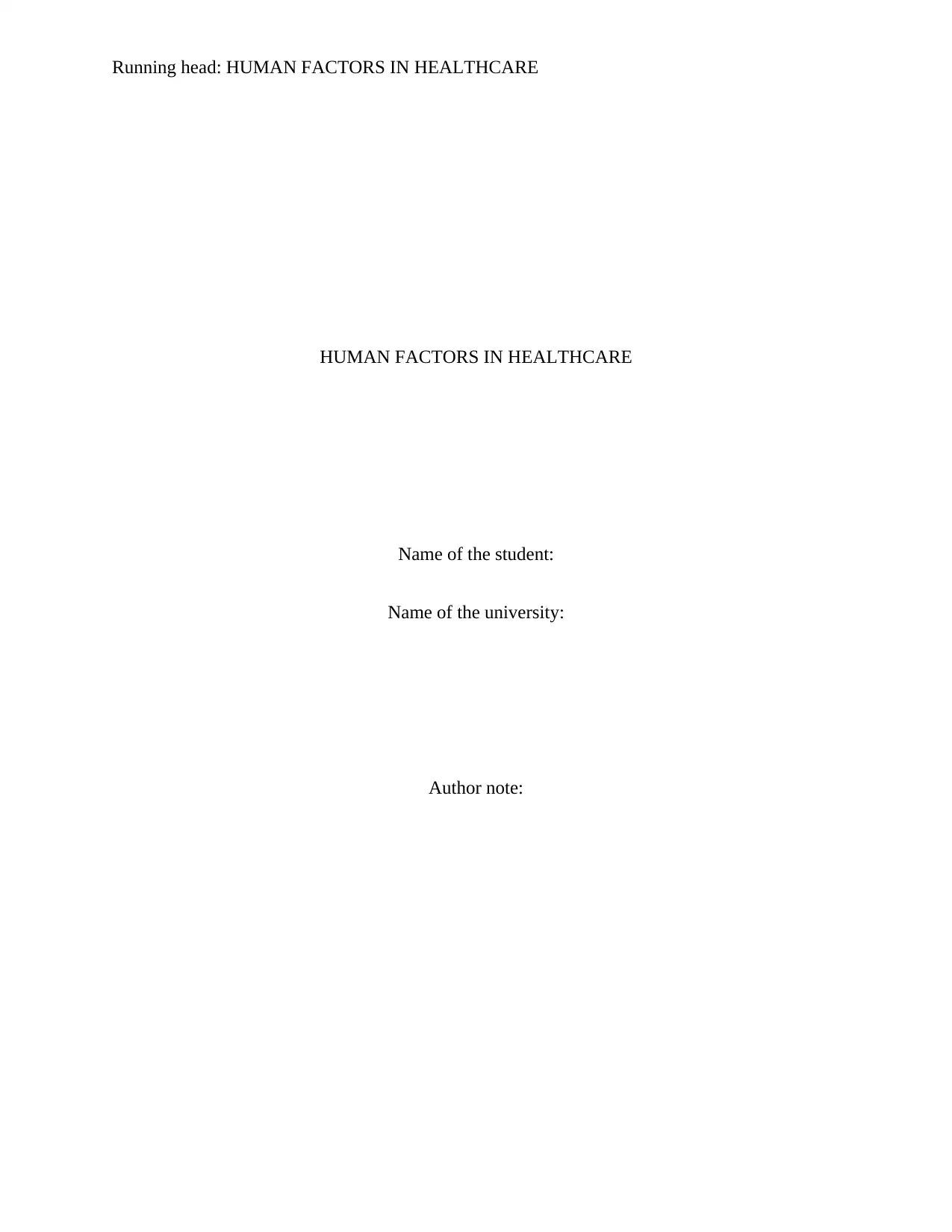
Running head: HUMAN FACTORS IN HEALTHCARE
HUMAN FACTORS IN HEALTHCARE
Name of the student:
Name of the university:
Author note:
HUMAN FACTORS IN HEALTHCARE
Name of the student:
Name of the university:
Author note:
Paraphrase This Document
Need a fresh take? Get an instant paraphrase of this document with our AI Paraphraser
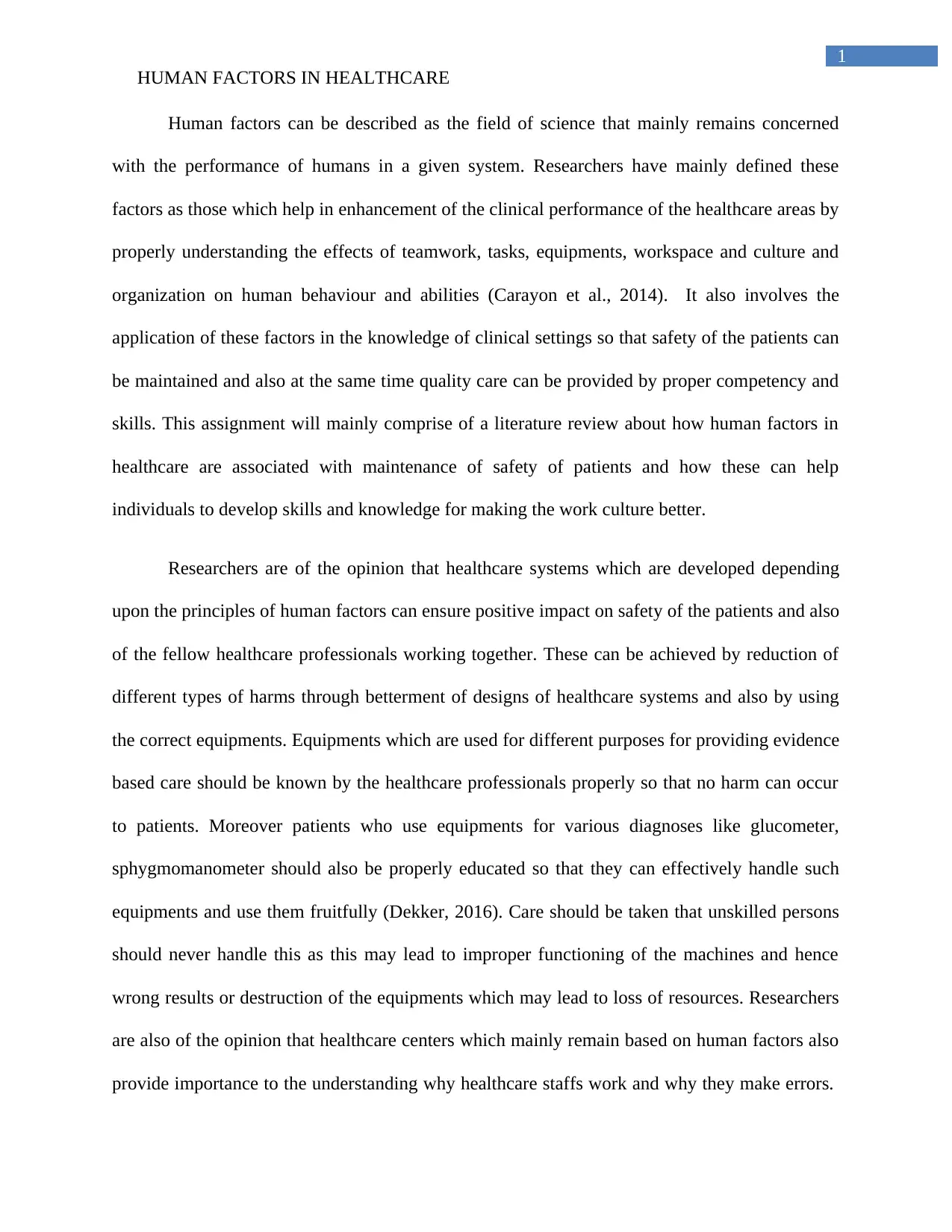
1
HUMAN FACTORS IN HEALTHCARE
Human factors can be described as the field of science that mainly remains concerned
with the performance of humans in a given system. Researchers have mainly defined these
factors as those which help in enhancement of the clinical performance of the healthcare areas by
properly understanding the effects of teamwork, tasks, equipments, workspace and culture and
organization on human behaviour and abilities (Carayon et al., 2014). It also involves the
application of these factors in the knowledge of clinical settings so that safety of the patients can
be maintained and also at the same time quality care can be provided by proper competency and
skills. This assignment will mainly comprise of a literature review about how human factors in
healthcare are associated with maintenance of safety of patients and how these can help
individuals to develop skills and knowledge for making the work culture better.
Researchers are of the opinion that healthcare systems which are developed depending
upon the principles of human factors can ensure positive impact on safety of the patients and also
of the fellow healthcare professionals working together. These can be achieved by reduction of
different types of harms through betterment of designs of healthcare systems and also by using
the correct equipments. Equipments which are used for different purposes for providing evidence
based care should be known by the healthcare professionals properly so that no harm can occur
to patients. Moreover patients who use equipments for various diagnoses like glucometer,
sphygmomanometer should also be properly educated so that they can effectively handle such
equipments and use them fruitfully (Dekker, 2016). Care should be taken that unskilled persons
should never handle this as this may lead to improper functioning of the machines and hence
wrong results or destruction of the equipments which may lead to loss of resources. Researchers
are also of the opinion that healthcare centers which mainly remain based on human factors also
provide importance to the understanding why healthcare staffs work and why they make errors.
HUMAN FACTORS IN HEALTHCARE
Human factors can be described as the field of science that mainly remains concerned
with the performance of humans in a given system. Researchers have mainly defined these
factors as those which help in enhancement of the clinical performance of the healthcare areas by
properly understanding the effects of teamwork, tasks, equipments, workspace and culture and
organization on human behaviour and abilities (Carayon et al., 2014). It also involves the
application of these factors in the knowledge of clinical settings so that safety of the patients can
be maintained and also at the same time quality care can be provided by proper competency and
skills. This assignment will mainly comprise of a literature review about how human factors in
healthcare are associated with maintenance of safety of patients and how these can help
individuals to develop skills and knowledge for making the work culture better.
Researchers are of the opinion that healthcare systems which are developed depending
upon the principles of human factors can ensure positive impact on safety of the patients and also
of the fellow healthcare professionals working together. These can be achieved by reduction of
different types of harms through betterment of designs of healthcare systems and also by using
the correct equipments. Equipments which are used for different purposes for providing evidence
based care should be known by the healthcare professionals properly so that no harm can occur
to patients. Moreover patients who use equipments for various diagnoses like glucometer,
sphygmomanometer should also be properly educated so that they can effectively handle such
equipments and use them fruitfully (Dekker, 2016). Care should be taken that unskilled persons
should never handle this as this may lead to improper functioning of the machines and hence
wrong results or destruction of the equipments which may lead to loss of resources. Researchers
are also of the opinion that healthcare centers which mainly remain based on human factors also
provide importance to the understanding why healthcare staffs work and why they make errors.
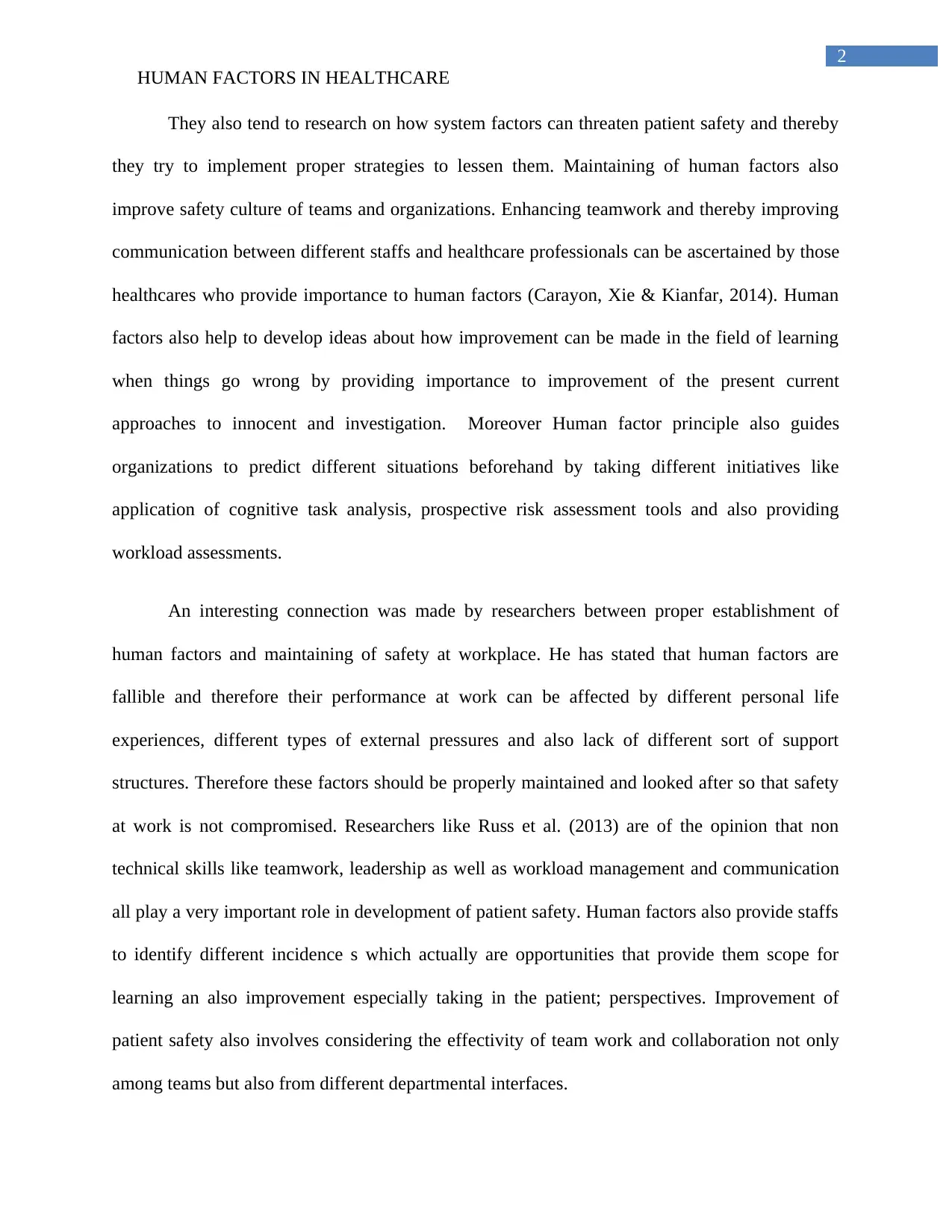
2
HUMAN FACTORS IN HEALTHCARE
They also tend to research on how system factors can threaten patient safety and thereby
they try to implement proper strategies to lessen them. Maintaining of human factors also
improve safety culture of teams and organizations. Enhancing teamwork and thereby improving
communication between different staffs and healthcare professionals can be ascertained by those
healthcares who provide importance to human factors (Carayon, Xie & Kianfar, 2014). Human
factors also help to develop ideas about how improvement can be made in the field of learning
when things go wrong by providing importance to improvement of the present current
approaches to innocent and investigation. Moreover Human factor principle also guides
organizations to predict different situations beforehand by taking different initiatives like
application of cognitive task analysis, prospective risk assessment tools and also providing
workload assessments.
An interesting connection was made by researchers between proper establishment of
human factors and maintaining of safety at workplace. He has stated that human factors are
fallible and therefore their performance at work can be affected by different personal life
experiences, different types of external pressures and also lack of different sort of support
structures. Therefore these factors should be properly maintained and looked after so that safety
at work is not compromised. Researchers like Russ et al. (2013) are of the opinion that non
technical skills like teamwork, leadership as well as workload management and communication
all play a very important role in development of patient safety. Human factors also provide staffs
to identify different incidence s which actually are opportunities that provide them scope for
learning an also improvement especially taking in the patient; perspectives. Improvement of
patient safety also involves considering the effectivity of team work and collaboration not only
among teams but also from different departmental interfaces.
HUMAN FACTORS IN HEALTHCARE
They also tend to research on how system factors can threaten patient safety and thereby
they try to implement proper strategies to lessen them. Maintaining of human factors also
improve safety culture of teams and organizations. Enhancing teamwork and thereby improving
communication between different staffs and healthcare professionals can be ascertained by those
healthcares who provide importance to human factors (Carayon, Xie & Kianfar, 2014). Human
factors also help to develop ideas about how improvement can be made in the field of learning
when things go wrong by providing importance to improvement of the present current
approaches to innocent and investigation. Moreover Human factor principle also guides
organizations to predict different situations beforehand by taking different initiatives like
application of cognitive task analysis, prospective risk assessment tools and also providing
workload assessments.
An interesting connection was made by researchers between proper establishment of
human factors and maintaining of safety at workplace. He has stated that human factors are
fallible and therefore their performance at work can be affected by different personal life
experiences, different types of external pressures and also lack of different sort of support
structures. Therefore these factors should be properly maintained and looked after so that safety
at work is not compromised. Researchers like Russ et al. (2013) are of the opinion that non
technical skills like teamwork, leadership as well as workload management and communication
all play a very important role in development of patient safety. Human factors also provide staffs
to identify different incidence s which actually are opportunities that provide them scope for
learning an also improvement especially taking in the patient; perspectives. Improvement of
patient safety also involves considering the effectivity of team work and collaboration not only
among teams but also from different departmental interfaces.
⊘ This is a preview!⊘
Do you want full access?
Subscribe today to unlock all pages.

Trusted by 1+ million students worldwide
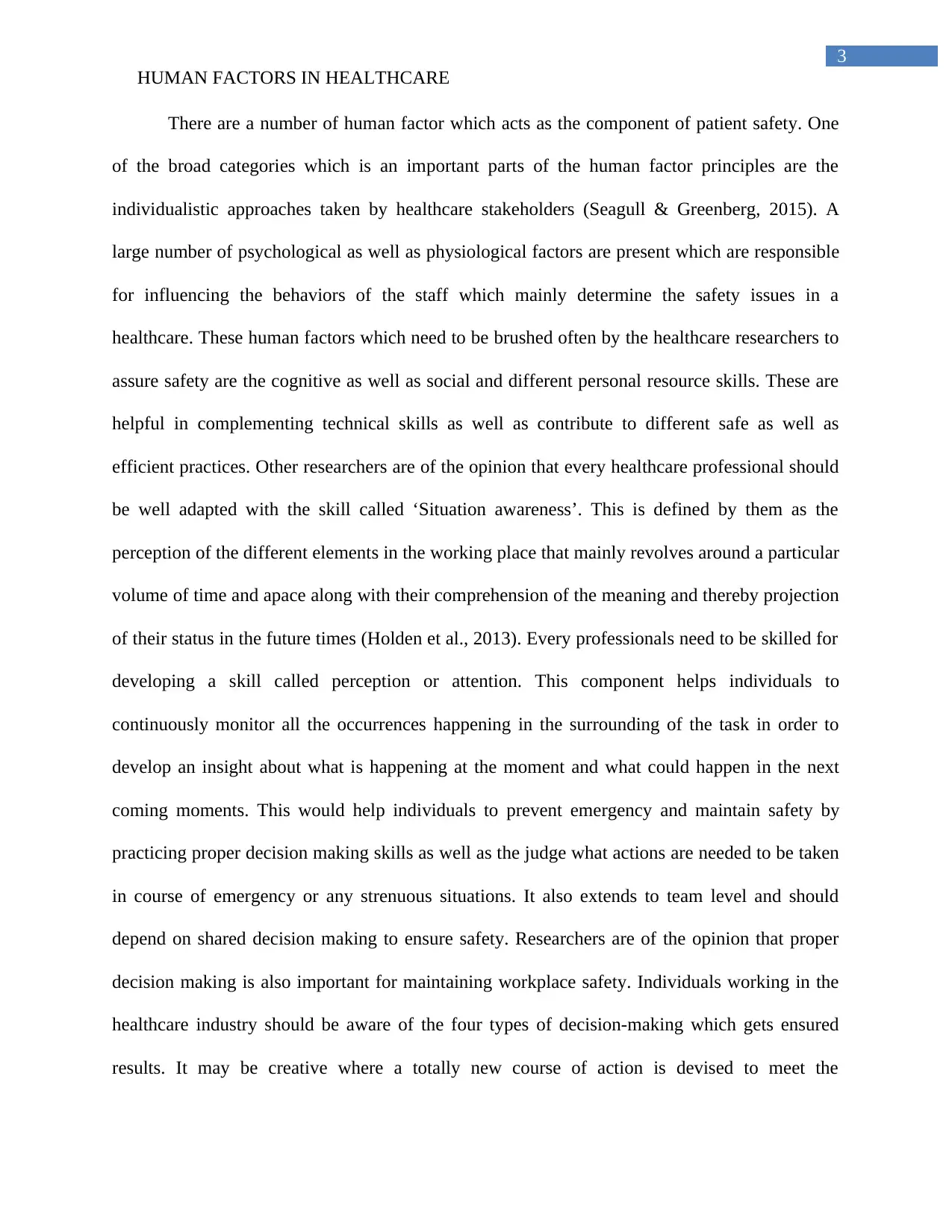
3
HUMAN FACTORS IN HEALTHCARE
There are a number of human factor which acts as the component of patient safety. One
of the broad categories which is an important parts of the human factor principles are the
individualistic approaches taken by healthcare stakeholders (Seagull & Greenberg, 2015). A
large number of psychological as well as physiological factors are present which are responsible
for influencing the behaviors of the staff which mainly determine the safety issues in a
healthcare. These human factors which need to be brushed often by the healthcare researchers to
assure safety are the cognitive as well as social and different personal resource skills. These are
helpful in complementing technical skills as well as contribute to different safe as well as
efficient practices. Other researchers are of the opinion that every healthcare professional should
be well adapted with the skill called ‘Situation awareness’. This is defined by them as the
perception of the different elements in the working place that mainly revolves around a particular
volume of time and apace along with their comprehension of the meaning and thereby projection
of their status in the future times (Holden et al., 2013). Every professionals need to be skilled for
developing a skill called perception or attention. This component helps individuals to
continuously monitor all the occurrences happening in the surrounding of the task in order to
develop an insight about what is happening at the moment and what could happen in the next
coming moments. This would help individuals to prevent emergency and maintain safety by
practicing proper decision making skills as well as the judge what actions are needed to be taken
in course of emergency or any strenuous situations. It also extends to team level and should
depend on shared decision making to ensure safety. Researchers are of the opinion that proper
decision making is also important for maintaining workplace safety. Individuals working in the
healthcare industry should be aware of the four types of decision-making which gets ensured
results. It may be creative where a totally new course of action is devised to meet the
HUMAN FACTORS IN HEALTHCARE
There are a number of human factor which acts as the component of patient safety. One
of the broad categories which is an important parts of the human factor principles are the
individualistic approaches taken by healthcare stakeholders (Seagull & Greenberg, 2015). A
large number of psychological as well as physiological factors are present which are responsible
for influencing the behaviors of the staff which mainly determine the safety issues in a
healthcare. These human factors which need to be brushed often by the healthcare researchers to
assure safety are the cognitive as well as social and different personal resource skills. These are
helpful in complementing technical skills as well as contribute to different safe as well as
efficient practices. Other researchers are of the opinion that every healthcare professional should
be well adapted with the skill called ‘Situation awareness’. This is defined by them as the
perception of the different elements in the working place that mainly revolves around a particular
volume of time and apace along with their comprehension of the meaning and thereby projection
of their status in the future times (Holden et al., 2013). Every professionals need to be skilled for
developing a skill called perception or attention. This component helps individuals to
continuously monitor all the occurrences happening in the surrounding of the task in order to
develop an insight about what is happening at the moment and what could happen in the next
coming moments. This would help individuals to prevent emergency and maintain safety by
practicing proper decision making skills as well as the judge what actions are needed to be taken
in course of emergency or any strenuous situations. It also extends to team level and should
depend on shared decision making to ensure safety. Researchers are of the opinion that proper
decision making is also important for maintaining workplace safety. Individuals working in the
healthcare industry should be aware of the four types of decision-making which gets ensured
results. It may be creative where a totally new course of action is devised to meet the
Paraphrase This Document
Need a fresh take? Get an instant paraphrase of this document with our AI Paraphraser
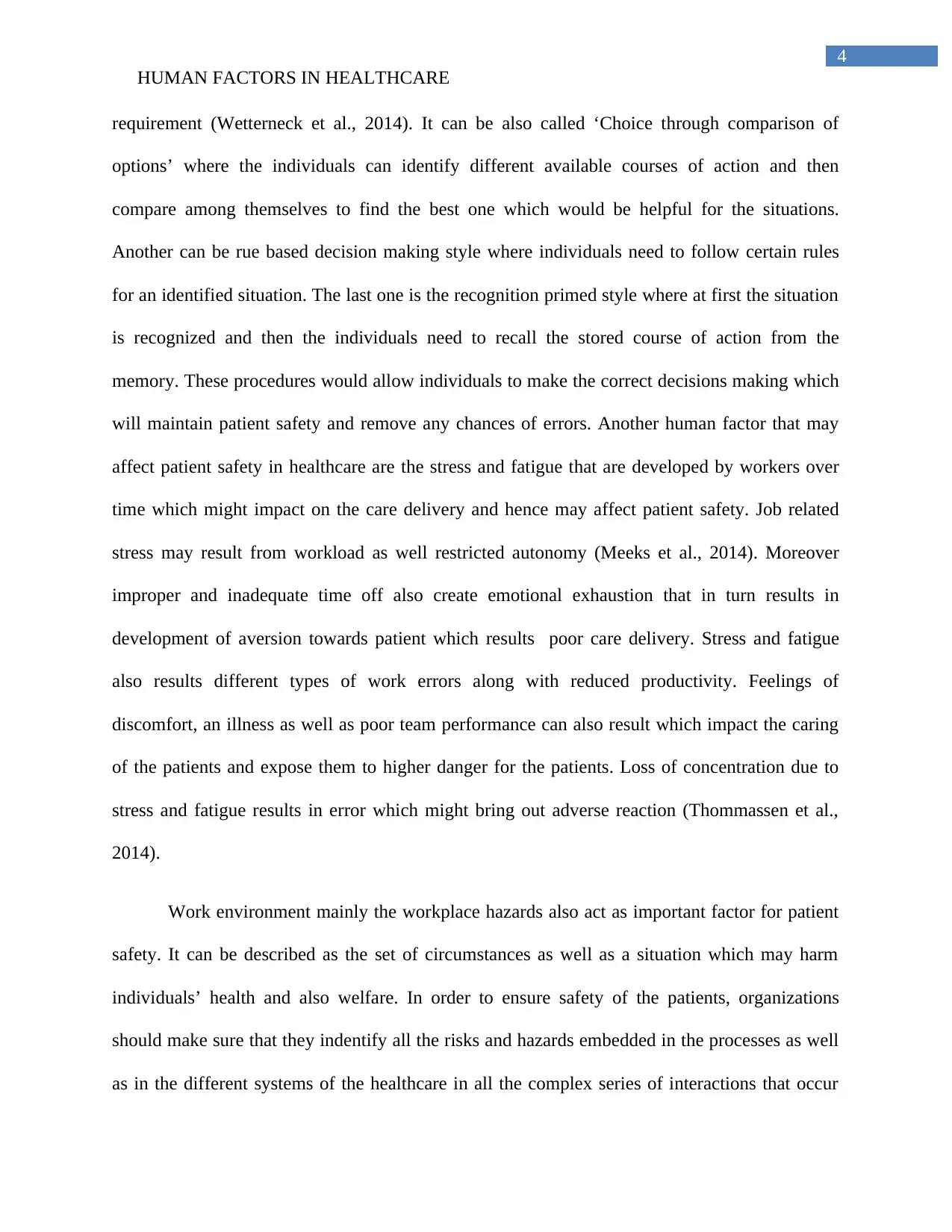
4
HUMAN FACTORS IN HEALTHCARE
requirement (Wetterneck et al., 2014). It can be also called ‘Choice through comparison of
options’ where the individuals can identify different available courses of action and then
compare among themselves to find the best one which would be helpful for the situations.
Another can be rue based decision making style where individuals need to follow certain rules
for an identified situation. The last one is the recognition primed style where at first the situation
is recognized and then the individuals need to recall the stored course of action from the
memory. These procedures would allow individuals to make the correct decisions making which
will maintain patient safety and remove any chances of errors. Another human factor that may
affect patient safety in healthcare are the stress and fatigue that are developed by workers over
time which might impact on the care delivery and hence may affect patient safety. Job related
stress may result from workload as well restricted autonomy (Meeks et al., 2014). Moreover
improper and inadequate time off also create emotional exhaustion that in turn results in
development of aversion towards patient which results poor care delivery. Stress and fatigue
also results different types of work errors along with reduced productivity. Feelings of
discomfort, an illness as well as poor team performance can also result which impact the caring
of the patients and expose them to higher danger for the patients. Loss of concentration due to
stress and fatigue results in error which might bring out adverse reaction (Thommassen et al.,
2014).
Work environment mainly the workplace hazards also act as important factor for patient
safety. It can be described as the set of circumstances as well as a situation which may harm
individuals’ health and also welfare. In order to ensure safety of the patients, organizations
should make sure that they indentify all the risks and hazards embedded in the processes as well
as in the different systems of the healthcare in all the complex series of interactions that occur
HUMAN FACTORS IN HEALTHCARE
requirement (Wetterneck et al., 2014). It can be also called ‘Choice through comparison of
options’ where the individuals can identify different available courses of action and then
compare among themselves to find the best one which would be helpful for the situations.
Another can be rue based decision making style where individuals need to follow certain rules
for an identified situation. The last one is the recognition primed style where at first the situation
is recognized and then the individuals need to recall the stored course of action from the
memory. These procedures would allow individuals to make the correct decisions making which
will maintain patient safety and remove any chances of errors. Another human factor that may
affect patient safety in healthcare are the stress and fatigue that are developed by workers over
time which might impact on the care delivery and hence may affect patient safety. Job related
stress may result from workload as well restricted autonomy (Meeks et al., 2014). Moreover
improper and inadequate time off also create emotional exhaustion that in turn results in
development of aversion towards patient which results poor care delivery. Stress and fatigue
also results different types of work errors along with reduced productivity. Feelings of
discomfort, an illness as well as poor team performance can also result which impact the caring
of the patients and expose them to higher danger for the patients. Loss of concentration due to
stress and fatigue results in error which might bring out adverse reaction (Thommassen et al.,
2014).
Work environment mainly the workplace hazards also act as important factor for patient
safety. It can be described as the set of circumstances as well as a situation which may harm
individuals’ health and also welfare. In order to ensure safety of the patients, organizations
should make sure that they indentify all the risks and hazards embedded in the processes as well
as in the different systems of the healthcare in all the complex series of interactions that occur
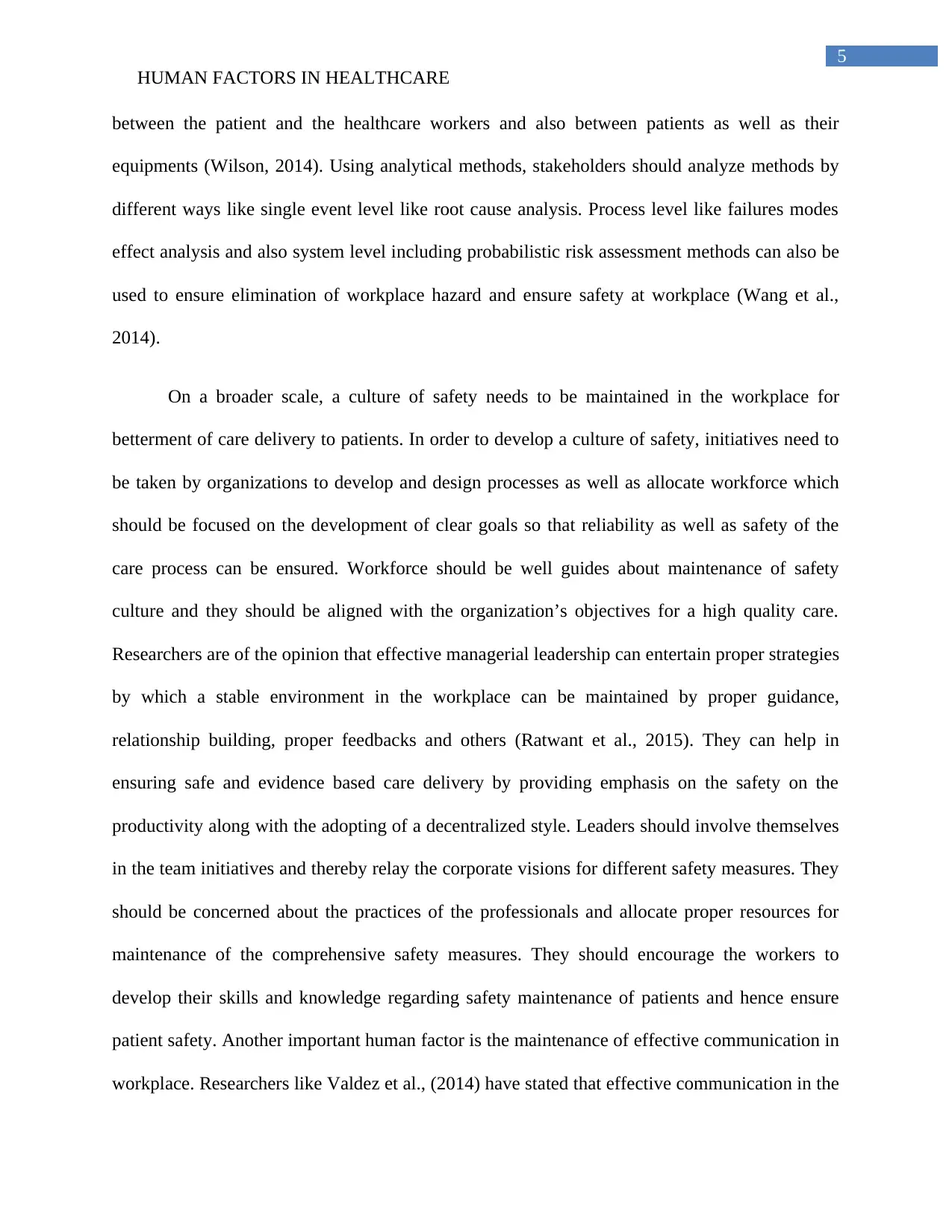
5
HUMAN FACTORS IN HEALTHCARE
between the patient and the healthcare workers and also between patients as well as their
equipments (Wilson, 2014). Using analytical methods, stakeholders should analyze methods by
different ways like single event level like root cause analysis. Process level like failures modes
effect analysis and also system level including probabilistic risk assessment methods can also be
used to ensure elimination of workplace hazard and ensure safety at workplace (Wang et al.,
2014).
On a broader scale, a culture of safety needs to be maintained in the workplace for
betterment of care delivery to patients. In order to develop a culture of safety, initiatives need to
be taken by organizations to develop and design processes as well as allocate workforce which
should be focused on the development of clear goals so that reliability as well as safety of the
care process can be ensured. Workforce should be well guides about maintenance of safety
culture and they should be aligned with the organization’s objectives for a high quality care.
Researchers are of the opinion that effective managerial leadership can entertain proper strategies
by which a stable environment in the workplace can be maintained by proper guidance,
relationship building, proper feedbacks and others (Ratwant et al., 2015). They can help in
ensuring safe and evidence based care delivery by providing emphasis on the safety on the
productivity along with the adopting of a decentralized style. Leaders should involve themselves
in the team initiatives and thereby relay the corporate visions for different safety measures. They
should be concerned about the practices of the professionals and allocate proper resources for
maintenance of the comprehensive safety measures. They should encourage the workers to
develop their skills and knowledge regarding safety maintenance of patients and hence ensure
patient safety. Another important human factor is the maintenance of effective communication in
workplace. Researchers like Valdez et al., (2014) have stated that effective communication in the
HUMAN FACTORS IN HEALTHCARE
between the patient and the healthcare workers and also between patients as well as their
equipments (Wilson, 2014). Using analytical methods, stakeholders should analyze methods by
different ways like single event level like root cause analysis. Process level like failures modes
effect analysis and also system level including probabilistic risk assessment methods can also be
used to ensure elimination of workplace hazard and ensure safety at workplace (Wang et al.,
2014).
On a broader scale, a culture of safety needs to be maintained in the workplace for
betterment of care delivery to patients. In order to develop a culture of safety, initiatives need to
be taken by organizations to develop and design processes as well as allocate workforce which
should be focused on the development of clear goals so that reliability as well as safety of the
care process can be ensured. Workforce should be well guides about maintenance of safety
culture and they should be aligned with the organization’s objectives for a high quality care.
Researchers are of the opinion that effective managerial leadership can entertain proper strategies
by which a stable environment in the workplace can be maintained by proper guidance,
relationship building, proper feedbacks and others (Ratwant et al., 2015). They can help in
ensuring safe and evidence based care delivery by providing emphasis on the safety on the
productivity along with the adopting of a decentralized style. Leaders should involve themselves
in the team initiatives and thereby relay the corporate visions for different safety measures. They
should be concerned about the practices of the professionals and allocate proper resources for
maintenance of the comprehensive safety measures. They should encourage the workers to
develop their skills and knowledge regarding safety maintenance of patients and hence ensure
patient safety. Another important human factor is the maintenance of effective communication in
workplace. Researchers like Valdez et al., (2014) have stated that effective communication in the
⊘ This is a preview!⊘
Do you want full access?
Subscribe today to unlock all pages.

Trusted by 1+ million students worldwide
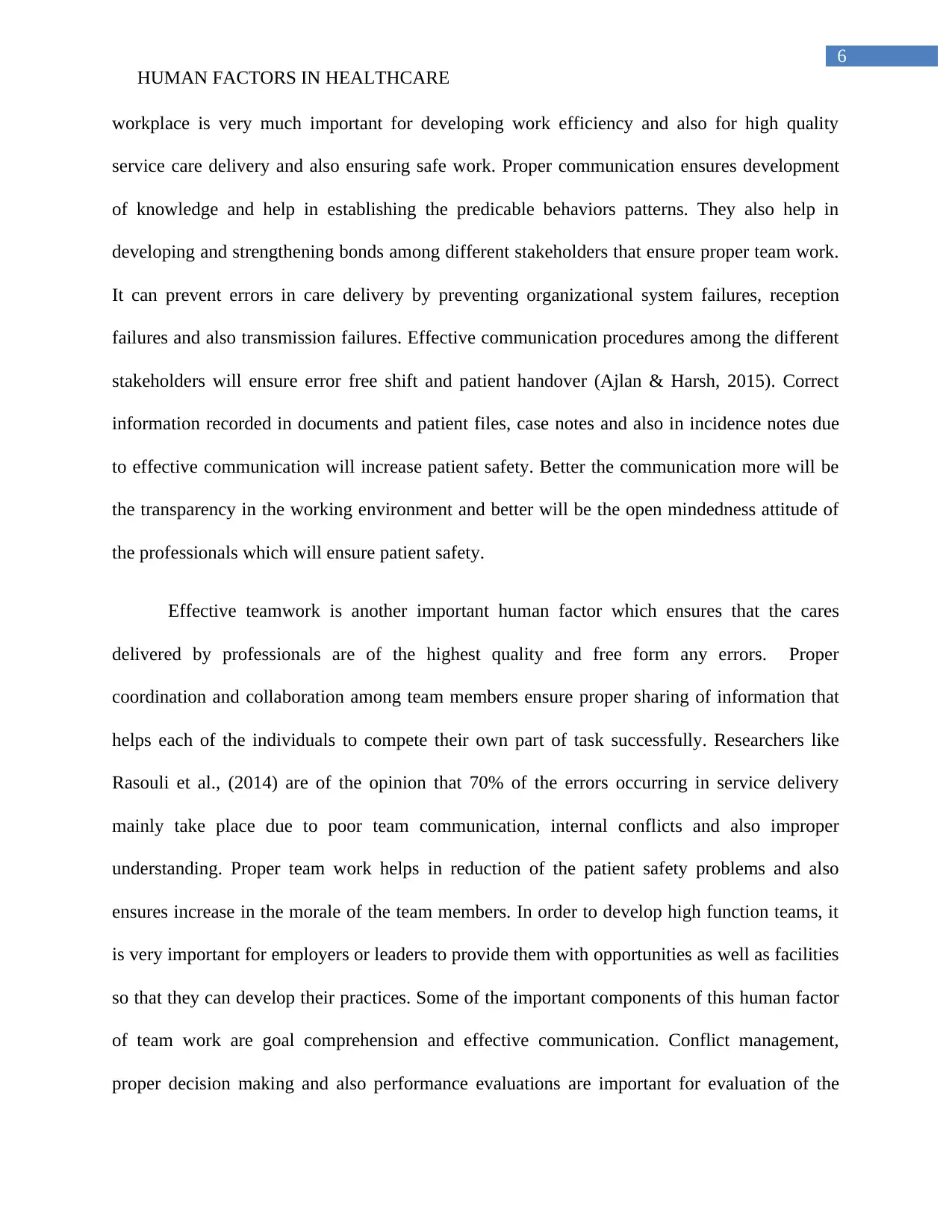
6
HUMAN FACTORS IN HEALTHCARE
workplace is very much important for developing work efficiency and also for high quality
service care delivery and also ensuring safe work. Proper communication ensures development
of knowledge and help in establishing the predicable behaviors patterns. They also help in
developing and strengthening bonds among different stakeholders that ensure proper team work.
It can prevent errors in care delivery by preventing organizational system failures, reception
failures and also transmission failures. Effective communication procedures among the different
stakeholders will ensure error free shift and patient handover (Ajlan & Harsh, 2015). Correct
information recorded in documents and patient files, case notes and also in incidence notes due
to effective communication will increase patient safety. Better the communication more will be
the transparency in the working environment and better will be the open mindedness attitude of
the professionals which will ensure patient safety.
Effective teamwork is another important human factor which ensures that the cares
delivered by professionals are of the highest quality and free form any errors. Proper
coordination and collaboration among team members ensure proper sharing of information that
helps each of the individuals to compete their own part of task successfully. Researchers like
Rasouli et al., (2014) are of the opinion that 70% of the errors occurring in service delivery
mainly take place due to poor team communication, internal conflicts and also improper
understanding. Proper team work helps in reduction of the patient safety problems and also
ensures increase in the morale of the team members. In order to develop high function teams, it
is very important for employers or leaders to provide them with opportunities as well as facilities
so that they can develop their practices. Some of the important components of this human factor
of team work are goal comprehension and effective communication. Conflict management,
proper decision making and also performance evaluations are important for evaluation of the
HUMAN FACTORS IN HEALTHCARE
workplace is very much important for developing work efficiency and also for high quality
service care delivery and also ensuring safe work. Proper communication ensures development
of knowledge and help in establishing the predicable behaviors patterns. They also help in
developing and strengthening bonds among different stakeholders that ensure proper team work.
It can prevent errors in care delivery by preventing organizational system failures, reception
failures and also transmission failures. Effective communication procedures among the different
stakeholders will ensure error free shift and patient handover (Ajlan & Harsh, 2015). Correct
information recorded in documents and patient files, case notes and also in incidence notes due
to effective communication will increase patient safety. Better the communication more will be
the transparency in the working environment and better will be the open mindedness attitude of
the professionals which will ensure patient safety.
Effective teamwork is another important human factor which ensures that the cares
delivered by professionals are of the highest quality and free form any errors. Proper
coordination and collaboration among team members ensure proper sharing of information that
helps each of the individuals to compete their own part of task successfully. Researchers like
Rasouli et al., (2014) are of the opinion that 70% of the errors occurring in service delivery
mainly take place due to poor team communication, internal conflicts and also improper
understanding. Proper team work helps in reduction of the patient safety problems and also
ensures increase in the morale of the team members. In order to develop high function teams, it
is very important for employers or leaders to provide them with opportunities as well as facilities
so that they can develop their practices. Some of the important components of this human factor
of team work are goal comprehension and effective communication. Conflict management,
proper decision making and also performance evaluations are important for evaluation of the
Paraphrase This Document
Need a fresh take? Get an instant paraphrase of this document with our AI Paraphraser
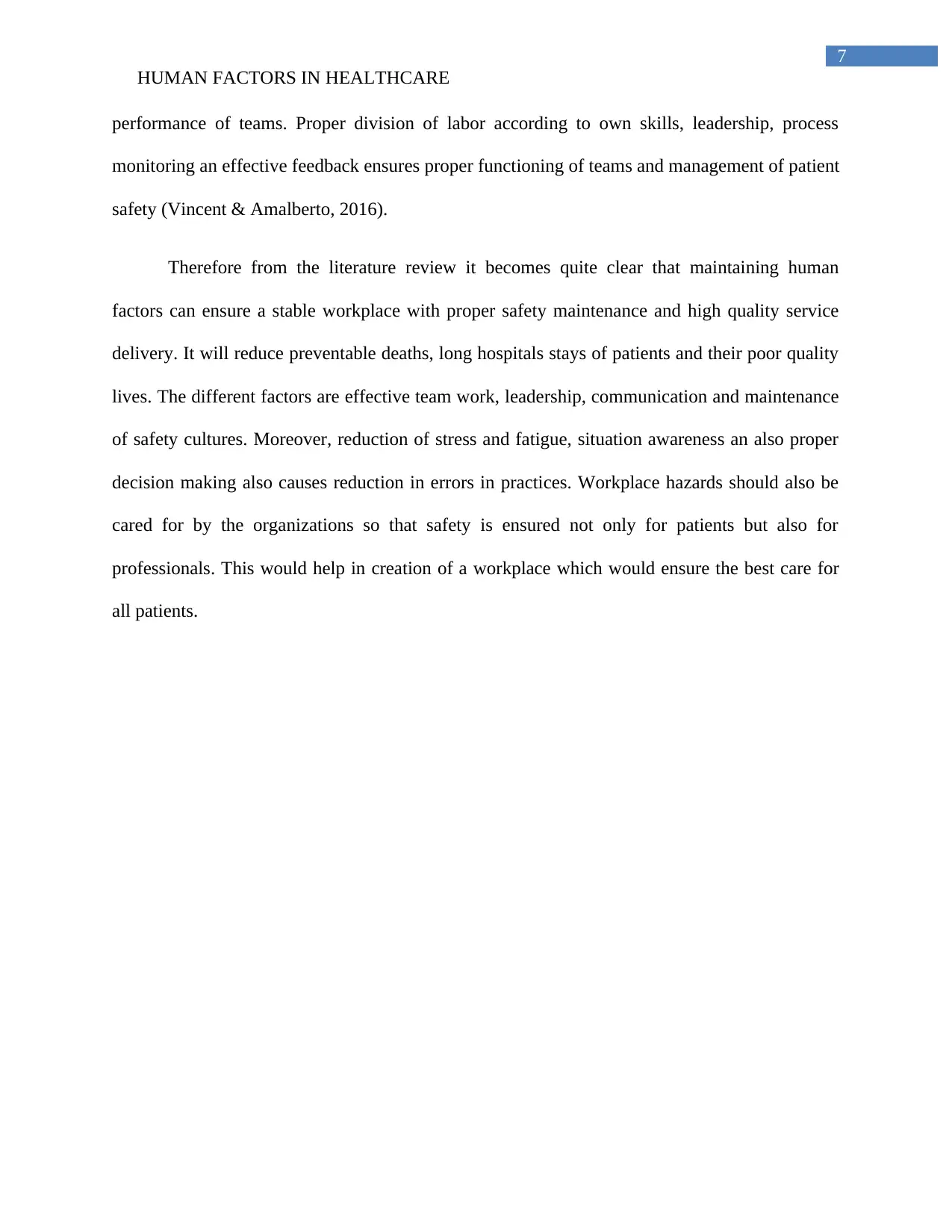
7
HUMAN FACTORS IN HEALTHCARE
performance of teams. Proper division of labor according to own skills, leadership, process
monitoring an effective feedback ensures proper functioning of teams and management of patient
safety (Vincent & Amalberto, 2016).
Therefore from the literature review it becomes quite clear that maintaining human
factors can ensure a stable workplace with proper safety maintenance and high quality service
delivery. It will reduce preventable deaths, long hospitals stays of patients and their poor quality
lives. The different factors are effective team work, leadership, communication and maintenance
of safety cultures. Moreover, reduction of stress and fatigue, situation awareness an also proper
decision making also causes reduction in errors in practices. Workplace hazards should also be
cared for by the organizations so that safety is ensured not only for patients but also for
professionals. This would help in creation of a workplace which would ensure the best care for
all patients.
HUMAN FACTORS IN HEALTHCARE
performance of teams. Proper division of labor according to own skills, leadership, process
monitoring an effective feedback ensures proper functioning of teams and management of patient
safety (Vincent & Amalberto, 2016).
Therefore from the literature review it becomes quite clear that maintaining human
factors can ensure a stable workplace with proper safety maintenance and high quality service
delivery. It will reduce preventable deaths, long hospitals stays of patients and their poor quality
lives. The different factors are effective team work, leadership, communication and maintenance
of safety cultures. Moreover, reduction of stress and fatigue, situation awareness an also proper
decision making also causes reduction in errors in practices. Workplace hazards should also be
cared for by the organizations so that safety is ensured not only for patients but also for
professionals. This would help in creation of a workplace which would ensure the best care for
all patients.
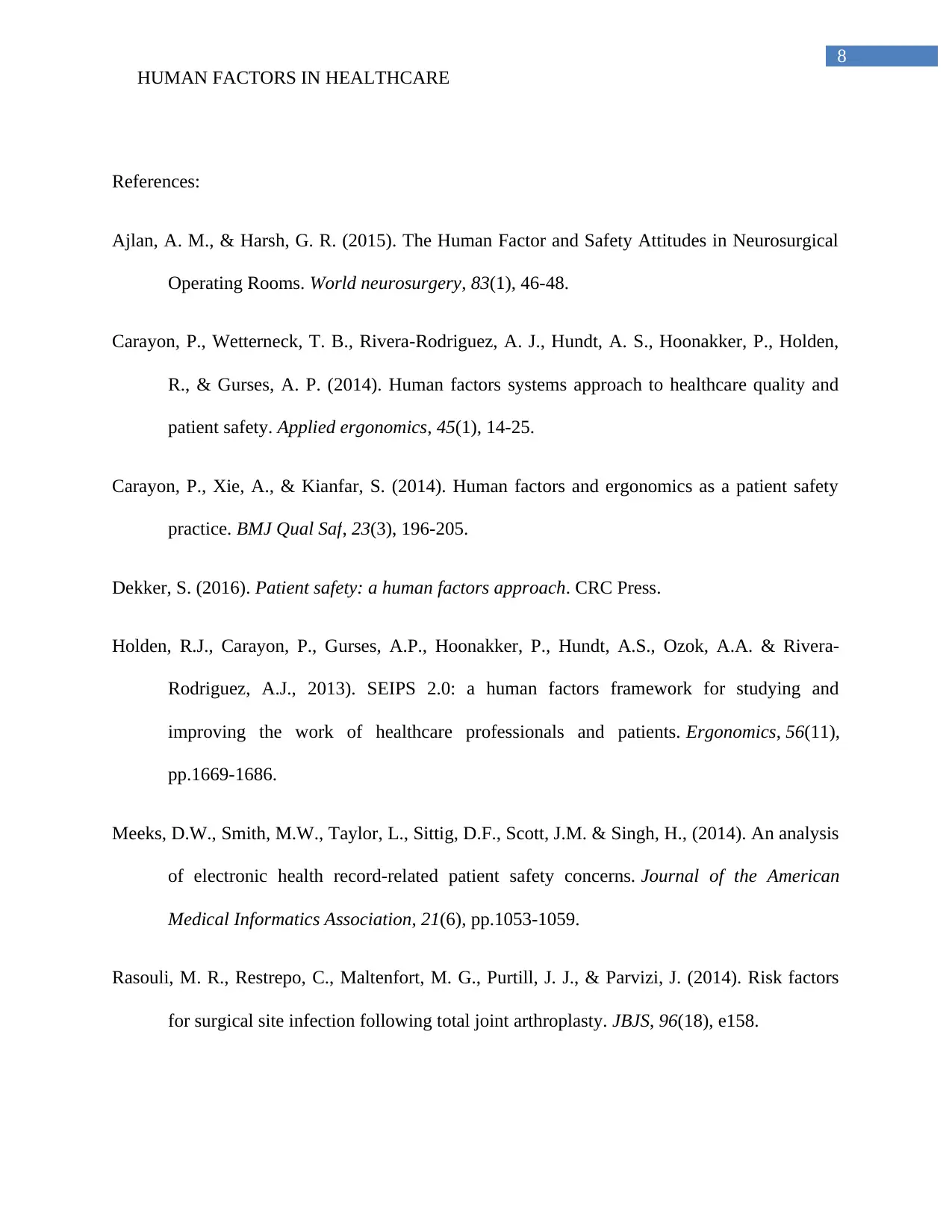
8
HUMAN FACTORS IN HEALTHCARE
References:
Ajlan, A. M., & Harsh, G. R. (2015). The Human Factor and Safety Attitudes in Neurosurgical
Operating Rooms. World neurosurgery, 83(1), 46-48.
Carayon, P., Wetterneck, T. B., Rivera-Rodriguez, A. J., Hundt, A. S., Hoonakker, P., Holden,
R., & Gurses, A. P. (2014). Human factors systems approach to healthcare quality and
patient safety. Applied ergonomics, 45(1), 14-25.
Carayon, P., Xie, A., & Kianfar, S. (2014). Human factors and ergonomics as a patient safety
practice. BMJ Qual Saf, 23(3), 196-205.
Dekker, S. (2016). Patient safety: a human factors approach. CRC Press.
Holden, R.J., Carayon, P., Gurses, A.P., Hoonakker, P., Hundt, A.S., Ozok, A.A. & Rivera-
Rodriguez, A.J., 2013). SEIPS 2.0: a human factors framework for studying and
improving the work of healthcare professionals and patients. Ergonomics, 56(11),
pp.1669-1686.
Meeks, D.W., Smith, M.W., Taylor, L., Sittig, D.F., Scott, J.M. & Singh, H., (2014). An analysis
of electronic health record-related patient safety concerns. Journal of the American
Medical Informatics Association, 21(6), pp.1053-1059.
Rasouli, M. R., Restrepo, C., Maltenfort, M. G., Purtill, J. J., & Parvizi, J. (2014). Risk factors
for surgical site infection following total joint arthroplasty. JBJS, 96(18), e158.
HUMAN FACTORS IN HEALTHCARE
References:
Ajlan, A. M., & Harsh, G. R. (2015). The Human Factor and Safety Attitudes in Neurosurgical
Operating Rooms. World neurosurgery, 83(1), 46-48.
Carayon, P., Wetterneck, T. B., Rivera-Rodriguez, A. J., Hundt, A. S., Hoonakker, P., Holden,
R., & Gurses, A. P. (2014). Human factors systems approach to healthcare quality and
patient safety. Applied ergonomics, 45(1), 14-25.
Carayon, P., Xie, A., & Kianfar, S. (2014). Human factors and ergonomics as a patient safety
practice. BMJ Qual Saf, 23(3), 196-205.
Dekker, S. (2016). Patient safety: a human factors approach. CRC Press.
Holden, R.J., Carayon, P., Gurses, A.P., Hoonakker, P., Hundt, A.S., Ozok, A.A. & Rivera-
Rodriguez, A.J., 2013). SEIPS 2.0: a human factors framework for studying and
improving the work of healthcare professionals and patients. Ergonomics, 56(11),
pp.1669-1686.
Meeks, D.W., Smith, M.W., Taylor, L., Sittig, D.F., Scott, J.M. & Singh, H., (2014). An analysis
of electronic health record-related patient safety concerns. Journal of the American
Medical Informatics Association, 21(6), pp.1053-1059.
Rasouli, M. R., Restrepo, C., Maltenfort, M. G., Purtill, J. J., & Parvizi, J. (2014). Risk factors
for surgical site infection following total joint arthroplasty. JBJS, 96(18), e158.
⊘ This is a preview!⊘
Do you want full access?
Subscribe today to unlock all pages.

Trusted by 1+ million students worldwide
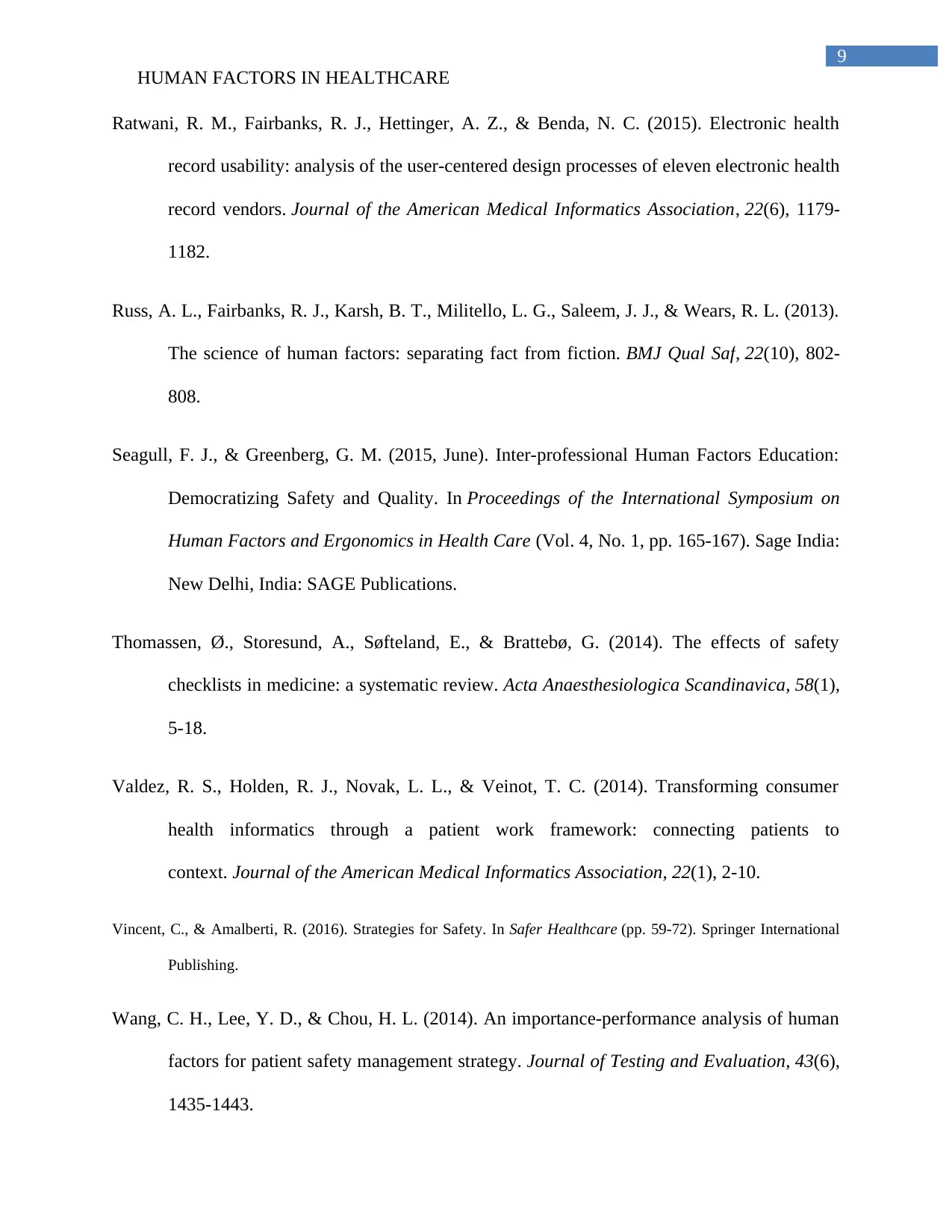
9
HUMAN FACTORS IN HEALTHCARE
Ratwani, R. M., Fairbanks, R. J., Hettinger, A. Z., & Benda, N. C. (2015). Electronic health
record usability: analysis of the user-centered design processes of eleven electronic health
record vendors. Journal of the American Medical Informatics Association, 22(6), 1179-
1182.
Russ, A. L., Fairbanks, R. J., Karsh, B. T., Militello, L. G., Saleem, J. J., & Wears, R. L. (2013).
The science of human factors: separating fact from fiction. BMJ Qual Saf, 22(10), 802-
808.
Seagull, F. J., & Greenberg, G. M. (2015, June). Inter-professional Human Factors Education:
Democratizing Safety and Quality. In Proceedings of the International Symposium on
Human Factors and Ergonomics in Health Care (Vol. 4, No. 1, pp. 165-167). Sage India:
New Delhi, India: SAGE Publications.
Thomassen, Ø., Storesund, A., Søfteland, E., & Brattebø, G. (2014). The effects of safety
checklists in medicine: a systematic review. Acta Anaesthesiologica Scandinavica, 58(1),
5-18.
Valdez, R. S., Holden, R. J., Novak, L. L., & Veinot, T. C. (2014). Transforming consumer
health informatics through a patient work framework: connecting patients to
context. Journal of the American Medical Informatics Association, 22(1), 2-10.
Vincent, C., & Amalberti, R. (2016). Strategies for Safety. In Safer Healthcare (pp. 59-72). Springer International
Publishing.
Wang, C. H., Lee, Y. D., & Chou, H. L. (2014). An importance-performance analysis of human
factors for patient safety management strategy. Journal of Testing and Evaluation, 43(6),
1435-1443.
HUMAN FACTORS IN HEALTHCARE
Ratwani, R. M., Fairbanks, R. J., Hettinger, A. Z., & Benda, N. C. (2015). Electronic health
record usability: analysis of the user-centered design processes of eleven electronic health
record vendors. Journal of the American Medical Informatics Association, 22(6), 1179-
1182.
Russ, A. L., Fairbanks, R. J., Karsh, B. T., Militello, L. G., Saleem, J. J., & Wears, R. L. (2013).
The science of human factors: separating fact from fiction. BMJ Qual Saf, 22(10), 802-
808.
Seagull, F. J., & Greenberg, G. M. (2015, June). Inter-professional Human Factors Education:
Democratizing Safety and Quality. In Proceedings of the International Symposium on
Human Factors and Ergonomics in Health Care (Vol. 4, No. 1, pp. 165-167). Sage India:
New Delhi, India: SAGE Publications.
Thomassen, Ø., Storesund, A., Søfteland, E., & Brattebø, G. (2014). The effects of safety
checklists in medicine: a systematic review. Acta Anaesthesiologica Scandinavica, 58(1),
5-18.
Valdez, R. S., Holden, R. J., Novak, L. L., & Veinot, T. C. (2014). Transforming consumer
health informatics through a patient work framework: connecting patients to
context. Journal of the American Medical Informatics Association, 22(1), 2-10.
Vincent, C., & Amalberti, R. (2016). Strategies for Safety. In Safer Healthcare (pp. 59-72). Springer International
Publishing.
Wang, C. H., Lee, Y. D., & Chou, H. L. (2014). An importance-performance analysis of human
factors for patient safety management strategy. Journal of Testing and Evaluation, 43(6),
1435-1443.
Paraphrase This Document
Need a fresh take? Get an instant paraphrase of this document with our AI Paraphraser
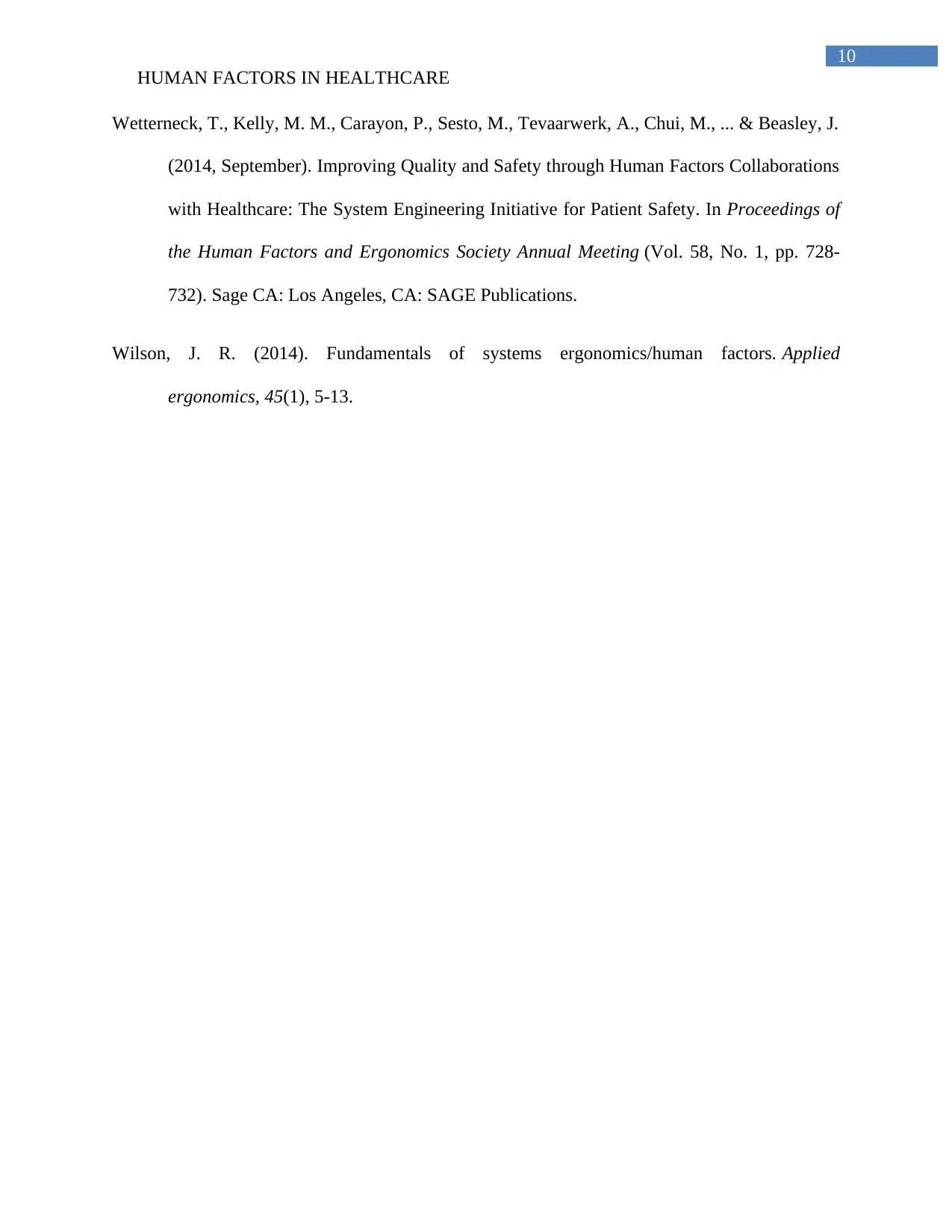
10
HUMAN FACTORS IN HEALTHCARE
Wetterneck, T., Kelly, M. M., Carayon, P., Sesto, M., Tevaarwerk, A., Chui, M., ... & Beasley, J.
(2014, September). Improving Quality and Safety through Human Factors Collaborations
with Healthcare: The System Engineering Initiative for Patient Safety. In Proceedings of
the Human Factors and Ergonomics Society Annual Meeting (Vol. 58, No. 1, pp. 728-
732). Sage CA: Los Angeles, CA: SAGE Publications.
Wilson, J. R. (2014). Fundamentals of systems ergonomics/human factors. Applied
ergonomics, 45(1), 5-13.
HUMAN FACTORS IN HEALTHCARE
Wetterneck, T., Kelly, M. M., Carayon, P., Sesto, M., Tevaarwerk, A., Chui, M., ... & Beasley, J.
(2014, September). Improving Quality and Safety through Human Factors Collaborations
with Healthcare: The System Engineering Initiative for Patient Safety. In Proceedings of
the Human Factors and Ergonomics Society Annual Meeting (Vol. 58, No. 1, pp. 728-
732). Sage CA: Los Angeles, CA: SAGE Publications.
Wilson, J. R. (2014). Fundamentals of systems ergonomics/human factors. Applied
ergonomics, 45(1), 5-13.
1 out of 11
Related Documents
Your All-in-One AI-Powered Toolkit for Academic Success.
+13062052269
info@desklib.com
Available 24*7 on WhatsApp / Email
![[object Object]](/_next/static/media/star-bottom.7253800d.svg)
Unlock your academic potential
Copyright © 2020–2025 A2Z Services. All Rights Reserved. Developed and managed by ZUCOL.





